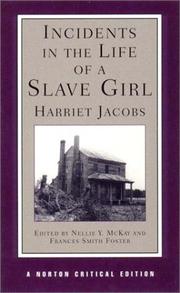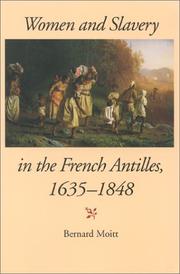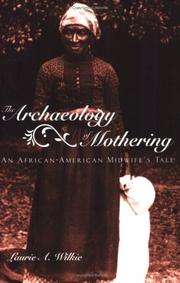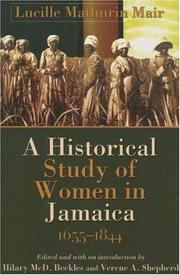| Listing 1 - 10 of 27 | << page >> |
Sort by
|

ISBN: 0393976378 Year: 2001 Publisher: New York (N.Y.) Norton
Abstract | Keywords | Export | Availability | Bookmark
 Loading...
Loading...Choose an application
- Reference Manager
- EndNote
- RefWorks (Direct export to RefWorks)
Slaves --- Women slaves --- Social conditions.

ISBN: 0253214521 0253339138 128206617X 0253108764 9780253108760 9780253339133 9780253214522 Year: 2001 Publisher: Bloomington, IN : Indiana University Press,
Abstract | Keywords | Export | Availability | Bookmark
 Loading...
Loading...Choose an application
- Reference Manager
- EndNote
- RefWorks (Direct export to RefWorks)
Women and Slavery in the French Antilles, 1635--1848Bernard MoittExamines the reaction of black women to slavery.In Women and Slavery in the French Antilles, 1635--1848, Bernard Moitt argues that gender had a profound effect on the slave plantation system in the French Antilles. He details and analyzes the social condition of enslaved black women in the plantation societies of Martinique, Guadeloupe, Saint-Domingue (now Haiti), and French Guiana from 1635 to the abolition
Women slaves --- Women, Black --- History --- History. --- Women slaves - West Indies, French - History. --- Women, Black - West Indies, French - History. --- Women slaves. --- Women, Black.
Book
ISBN: 1461906741 9781461906742 9789766402259 9766402256 Year: 2010 Publisher: Kingston, Jamaica : University of the West Indies Press,
Abstract | Keywords | Export | Availability | Bookmark
 Loading...
Loading...Choose an application
- Reference Manager
- EndNote
- RefWorks (Direct export to RefWorks)
Women --- Enslaved women --- History. --- Social conditions. --- Economic conditions. --- Women slaves

ISBN: 1136755446 0429236468 1283711524 1136755454 0203821173 9781136755453 9780203821176 9781136755408 1136755403 9781136755446 0415945690 9780415945691 0415945704 9780415945707 Year: 2003 Publisher: New York : Routledge,
Abstract | Keywords | Export | Availability | Bookmark
 Loading...
Loading...Choose an application
- Reference Manager
- EndNote
- RefWorks (Direct export to RefWorks)
Using archaeological materials recovered from a housesite in Mobile, Alabama, Laurie Wilkie explores how one extended African-American family engaged with competing and conflicting mothering ideologies in the post-Emancipation South.
African American midwives --- African American mothers --- Women slaves --- Motherhood --- Social conditions. --- History. --- Perryman, Lucrecia. --- Enslaved women

ISBN: 9766401780 1435689755 9781435689756 9789766401788 9789766401788 Year: 2006 Publisher: Jamaica : University of the West Indies Press,
Abstract | Keywords | Export | Availability | Bookmark
 Loading...
Loading...Choose an application
- Reference Manager
- EndNote
- RefWorks (Direct export to RefWorks)
In 1974 Lucille Mathurin Mair defended her dissertation, which has since become a classic work in Caribbean historiography and influenced generations of scholars. Through extensive archival work with estate records, legal records, family papers and private correspondence, she sought out the women of Jamaica's past during slavery, women of all classes, all colours black, brown and white. The work stands as a convincing exposure of women as agents of history - a path-breaking achievement at a time when Caribbean historiography ignored women. From her meticulous research emerged a powerful statement that has shaped subsequent understandings of gendered and cultural relations in Jamaican society: the white woman consumed, the coloured woman served and the black woman laboured. Over three decades Mair's dissertation became the most sought after unpublished work among students and scholars of Caribbean history and culture. Now available as a published monograph, the work will be more widely available to a new generation of scholars concerned with Atlantic history, slavery, culture and gender. The editors have provided a useful and informative introduction and a bibliography, containing the original bibliography in the dissertation now supplemented by bibliographies detailing Mathurin Mair's subsequent publications, subsequent UWI theses on women or gender, and books, articles and papers on Caribbean gender issues since 1974.
Women --- Women slaves --- Slave labor --- Forced labor --- Slave women --- Slaves --- Human females --- Wimmin --- Woman --- Womon --- Womyn --- Females --- Human beings --- Femininity --- History. --- Jamaica --- Enslaved women --- Women, Enslaved --- Enslaved persons --- Women slaves. --- Slave labor. --- Enslaved women.
Book
ISBN: 1438429665 144163889X 9781441638892 9781438429663 1438429649 1438429657 9781438429649 9781438429656 9781438429663 Year: 2010 Publisher: Albany : State University of New York Press,
Abstract | Keywords | Export | Availability | Bookmark
 Loading...
Loading...Choose an application
- Reference Manager
- EndNote
- RefWorks (Direct export to RefWorks)
Critical edition of three women's oral slave narratives.
Slavery --- Women slaves --- History --- Dubois, Silvia, --- Jackson, Mattie J. --- Picquet, Louisa, --- Enslaved women --- Women, Enslaved --- Enslaved persons
Book
ISBN: 1442208724 1442208732 9781442208735 9781442208711 1442208716 Year: 2015 Publisher: Lanham, Maryland : Rowman & Littlefield,
Abstract | Keywords | Export | Availability | Bookmark
 Loading...
Loading...Choose an application
- Reference Manager
- EndNote
- RefWorks (Direct export to RefWorks)
"For generations female slaves have played prominent roles throughout American history, but more than a century after Emancipation, no comprehensive overview of the history of the female American slave exists. In this book, historian Emily West offers the first comprehensive overview of the lives of enslaved women in America by placing their stories within the broader context of slavery in this country from the colonial era through to the end of the Civil War"--Provided by publisher.
Women slaves --- African American women --- Slavery --- Slave women --- Slaves --- History. --- United States --- Race relations --- Women, Enslaved --- Enslaved persons --- Enslaved women
Book
ISBN: 0820354023 082035404X 0820354031 9780820354026 9780820354033 9780820354040 Year: 2018 Publisher: Athens, Georgia : Baltimore, Md. : University of Georgia Press, Project MUSE,
Abstract | Keywords | Export | Availability | Bookmark
 Loading...
Loading...Choose an application
- Reference Manager
- EndNote
- RefWorks (Direct export to RefWorks)
"Editors Harris and Berry first conceived of this discussion -- one of the history and relationship between slavery and sexuality -- at a conference at the University of Texas at Austin in October 2011. The meeting encouraged a series of healthy dialogues with the general public, seasoned scholars, and those just beginning to learn about and research these topics of slavery and sexual intimacy. A select group of scholars met again in the fall of 2012 in New York to continue the conversation. This volume is a result of these ongoing conversations, with additional scholarly voices added as the project evolved. The volume places sexuality at the center of slavery studies in the Americas (the United States, Carribbean, and South America). In many mainstream histories of slavery, the editors argue that scholars have marginalized or simply overlooked the importance of sexual practices. But sexual intimacy comprised a core terrain of struggle between slaveholders and the enslaved. The essays explore consensual sexual intimacy and expression within slave communities, as well as sexual relationships across lines of race, status, and power. Contributors explore sexuality as a tool of control, exploitation and repression, and also as an expression of autonomy, resistance, and defiance. Essayists include Jim Downs, Sowande' Mustakeem, Bianca Premo, Marisa J. Guentes, Trevor Burnard, Jessica Millward, Leslie Harris, Thomas Foster, David Doddington, and Stephanie Jones-Rogers. All essays except those by Foster and Camp are new and were expressly written for this volume"--
Slaves --- Women slaves --- Slavery --- Enslaved persons --- Persons --- Slave women --- Social conditions. --- History. --- Sexual behavior --- Women, Enslaved --- Enslaved women
Book
ISBN: 1474285333 1472569326 1472569318 9781472569318 9781472569325 9781472569301 147256930X Year: 2020 Publisher: London, England : London, England : Bloomsbury Academic, an imprint of Bloomsbury Publishing, Plc, Bloomsbury Publishing,
Abstract | Keywords | Export | Availability | Bookmark
 Loading...
Loading...Choose an application
- Reference Manager
- EndNote
- RefWorks (Direct export to RefWorks)
In Caribbean history, the European colonial plantocracy created a cultural diaspora in which African slaves were torn from their ancestral homeland. In order to maintain vital links to their traditions and culture, slaves retained certain customs and nurtured them in the Caribbean. The creation of lace-bark cloth from the lagetta tree was a practice that enabled slave women to fashion their own clothing, an exercise that was both a necessity, as clothing provisions for slaves were poor, and empowering, as it allowed women who participated in the industry to achieve some financial independence. This is the first book on the subject and, through close collaboration with experts in the field including Maroon descendants, scientists and conservationists, it offers a pioneering perspective on the material culture of Caribbean slaves, bringing into focus the dynamics of race, class and gender. Focusing on the time period from the 1660s to the 1920s, it examines how the industry developed, the types of clothes made, and the people who wore them. The study asks crucial questions about the social roles that bark cloth production played in the plantation economy and colonial society, and in particular explores the relationship between bark cloth production and identity amongst slave women.
Tapa --- Women slaves --- Blacks --- Clothing and dress --- Social aspects --- Clothing --- Material culture --- History. --- Enslaved women --- Black people
Book
ISBN: 9780199754083 9786611987091 0199710643 9780199710645 0195366565 9780195366563 1281987093 9781281987099 6611987096 0199887853 0197714765 019975408X 9780199887859 Year: 2009 Publisher: Oxford ; New York : Oxford University Press,
Abstract | Keywords | Export | Availability | Bookmark
 Loading...
Loading...Choose an application
- Reference Manager
- EndNote
- RefWorks (Direct export to RefWorks)
In telling the life of Harriet, Dred's wife and co-litigant in the case, this book provides a compensatory history to the generations of work that missed key sources only recently brought to light. Moreover, it gives insight into the reasons and ways that slaves used the courts to establish their freedom. --from publisher description.
Women slaves --- Slaves --- Scott, Harriet, --- Scott, Dred, --- Robinson, Harriet, --- Scott, Harriett Robinson, --- Family. --- Enslaved women --- Women, Enslaved --- Enslaved persons --- Trials, litigation, etc.
| Listing 1 - 10 of 27 | << page >> |
Sort by
|

 Search
Search Feedback
Feedback About UniCat
About UniCat  Help
Help News
News